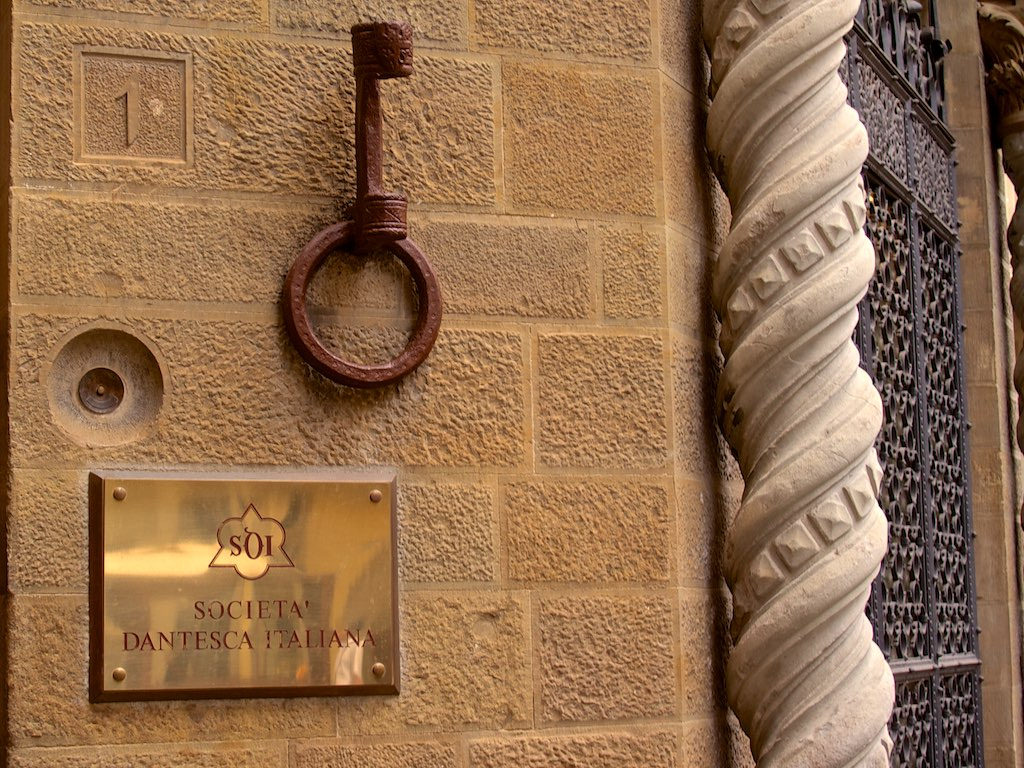Dante and his Divine Comedy is a ‘hot’ topic lately, thanks to Dan Brown’s latest mystery, Inferno, set mainly in Florence (see page 18). However, few visitors to the city know that 24,000 Dante-inspired volumes can be found at Florence’s Società Dantesca Italiana, a cultural center and library located just steps from piazza della Repubblica.
In 2015, Florence will be celebrating the 750th anniversary of Dante’s birth. Did you know that no autographed document of the poet has survived throughout the centuries? Even more surprising, historians have yet to uncover an original manuscript of his Divine Comedy or discover even a single scrawl of his signature. Yet, after his death, copies of his work were distributed throughout Italy, created by numerous copyists commissioned to reproduce his works in the fourteenth and fifteenth centuries. The work of these laborers in various manuscript workshops played a huge hand in making the poet’s works widely known and popular, a mission that was later embraced by the Società Dantesca Italiana.
First granted official status in Palazzo Vecchio’s Sala di Leone X in 1888, the Società Dantesca Italiana and its library were originally housed at Florence’s Accademia della Crusca. Its founding was of fundamental importance. At the time, Italy was still a budding nation, and politicians and intellectuals looked to Dante’s daunting, encyclopedic Divine Comedy as a source of much-needed national identity. Indeed, Italy’s founding fathers decided that the Florentine dialect would be the newly united country’s national language, their choice reflecting Dante’s widely recognized status as literary master.
Reading Dante aloud is a long tradition in Florence (the first public reading was given in 1373 at the Badia Fiorentina: the municipality of Florence hired Boccaccio for the job). The Società Dantesca Italiana first began organizing public readings of Dante’s works in 1893.
In 1905, in the presence of Margherita, the first queen of Italy, the society opened its new headquarters in the Palagio dell’Arte della Lana, the tower-house palace that had once housed the city’s powerful wool guild, which enjoyed high status as one of the city’s major guilds. Architecturally linked to Orsanmichele, the ancient church and granary, this palace is one of Florence’s oldest, most well-preserved buildings. To help raise funds, the society’s first president, Florence mayor Pietro Torrigiani, encouraged noble Florentine families to have their coat of arms painted in the palace for a contribution of 250 lire. Fragments of those frescoes can still be seen there today. Several of these patrons were member of such local dynasties as the Ginori, Peruzzi de’ Medici, Rucellai, Niccolini, Farinola, Avila, Strozzi and della Gherardesca, whose families continue to reside in Florence today.
The society’s exquisite second-floor library, in Sala Francesco Mazzoni, offers reference materials for scholars and students, as well as collections of ancient codices, incunabula and major editions of Dante’s works published from around the world. Its impressive collection counts some 24,000 volumes, whose topics range from contemporary Dante studies and modern Italian philosophy to medieval poetry and the study of romance languages.
Nonetheless, in the midst of this ancient grandeur, the Società Dantesca Italiana has embraced digital technology. In 1972, it began reproducing Dante’s manuscripts in digital form, bringing together all versions of his works from libraries around the world. Fulfilling the society’s goal of creating one virtual library, free to the public (online public-access catalog, see box), this far-reaching program allows scholars and aficionados to quickly find all the Dante-related information they might possibly need—all in one place.
For those who can get there, however, a visit to the society itself is even better. It is truly one of the city’s hidden gems. When I visited, the librarian brought out stunning copies of Botticelli’s drawings for the Inferno, which are said to have inspired Baccio Baldini’s engravings that accompanied the first edition of The Divine Comedy, published in Florence in 1481. Botticelli planned to illustrate each canto; whether he reached his goal or not is unknown, for only 92 drawings survive.
While on a tour of the Palagio dell’Arte della Lana, don’t forget that one of the building’s most enticing highlights is its view of Florence from the rooftop terrace. Go drink in the view!
Società Dantesca Italiana
Palagio dell’Arte della Lana
Via Arte della Lana 1
50123 Florence
Library: Monday–Friday, 9:30am–1:30pm; Thursday, 9:30am–1:30pm; 2:30pm–5:30pm









